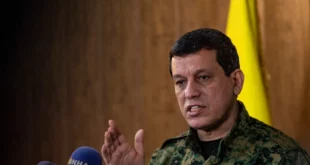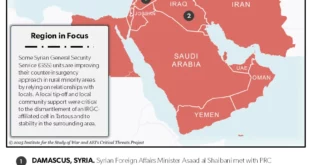The immigrants were arriving on children’s bicycles and sometimes even in wheelchairs. According to Norwegian law, immigrants couldn’t cross the border by foot. So, in 2015, they were traveling from Russia to the far north of Norway on any conveyance they could find.
It was an odd choice of a place to cross into the West. Norway and Russia share a border way up north in the Arctic Circle. The 5,500 asylum-seekers were not Russians. They came from far away to the south: Syria, Afghanistan, Iraq, and Yemen, along with 43 other countries. What were they doing in this cold, remote part of the world?
The Norwegians were suspicious. Some of the new arrivals spoke Russian and had been living in Russia for some time. The Police Security Service (PST) had several theories. It believed that the Russians were using the immigrants as a wedge to disrupt Norwegian society by adding strain to the welfare state. Then there was the political angle. Norway’s far-right Progress Party, opposed to immigration from the Global South, could benefit from the crisis, disrupting the Scandinavian reputation for tolerance and complicating Norway’s relationship to the European Union. Given how integrated some of the migrants had been in Russian society, the PST also suspected that some of them were tasked with collecting information for Russian intelligence.
The strange saga of asylum-seekers from the Middle East riding bicycles into arctic Norway is not unique. Countries and non-state actors have long used migrants and refugees as a vehicle to achieve geopolitical ends. Think of how imperial states have sent their own citizens as migrants to expand colonial reach in Asia, Africa, and the Americas.
Nor is it unusual within countries for immigrants to be misused in this manner. The governors of Texas and Florida packed refugees onto buses and planes bound for northern cities, also to promote discord and burden social services in an effort to undermine Democratic-controlled municipalities.
Immigration is a go-to political weapon for the far right. It has used the issue to amplify the economic anxieties of the base (“they’ve coming to take our jobs”), the cultural fears of majority-white populations (“they’re coming to replace us”), and the specific political worries of conservatives (“they’re going to bankrupt our welfare state”).
The difference today is that the far right is not just using the rhetoric of anti-immigration. It is using the actual immigrants themselves as weapons.
The Russian Game
For Vladimir Putin, it’s a win-win stratagem to support a surge of migration into Europe.
From his point of view, waves of immigrants challenge the cohesiveness of the European Union—generating endless arguments among member states about how to address the problem—and boost support for his far-right political allies like the National Assembly in France and the Alternative für Deutschland in Germany.
Putin launched his war against Ukraine to seize control of his neighbor, not with the primary goal of sending Ukrainians streaming out of the country. But the exodus has served Putin’s purposes by once again ripping the bandage off the immigration question in the EU and challenging Europe’s commitment to supporting Kyiv. It has had the side benefit of triggering the exit of many Russians from Russia, depleting the ranks of the opposition.
The country that has hosted the most Ukrainians is Germany. Anger over the state’s generous treatment of these refugees was a major factor in the far right’s electoral victory in Thuringia and its second-place finishes in Saxony and Brandenburg. A bonus for Putin is that the “left” party—Bündnis Sahra Wagenknecht—has adopted the same anti-immigrant, anti-Ukraine positions, which propelled it to unexpectedly strong results in those elections as well. Both the far right and this bogus left have adopted effectively pro-Russian positions around support for an immediate ceasefire in the war that locks in Russia’s territorial gains.
Putin also acts through allied intermediaries. Belarus, for instance, has used a similar strategy against neighboring Poland. In 2021, the Belarusian government attracted migrants to Minsk with promises that they could get into Europe. It then helped ferry those immigrants to the frontier where border guards reportedly cut through fences to allow them into Poland. For years, Poland has been a home for activists trying to get rid of Aleksandr Lukashenko. The dictator has struck back not with bombs and missiles but with desperate refugees.
This year the problem reemerged as attempted border crossings from Belarus jumped from a negligible number to nearly 400 a day. A knifing of a Polish border guard, who died of his injuries, prompted Poland to establish a buffer zone with various walls and barriers. Poland’s fortification of the border achieves another Lukashenko goal: cutting Belarus off from Europe. Exiled Belarusian opposition leader, Svetlana Tikhanovskaya, has appealed to Warsaw: “Initiatives to limit border traffic due to the regime’s ongoing provocations should target the dictator, not the people. We cannot abandon Belarusians to their fate behind a new iron curtain.”
Out of Latin America
Daniel Ortega doesn’t fit the usual definition of a far-right leader. After all, Ortega was a leader of the leftist Sandinistas who overthrew a Nicaraguan dictator allied with the United States. But when Ortega won reelection in 2006, he charted a different political path. He cracked down any and all opposition, including many leftists and former Sandinistas. He aligned himself with the Catholic Church and supported a complete ban on abortion. He has enriched himself and his family through corrupt practices.
But he remains consistent in one respect: he still deeply dislikes the United States. Nicaragua is suffering under U.S. sanctions, and Ortega has come up with a novel way of wreaking revenge. Ortega’s government has loosened restrictions so that around 200,000 people from a dozen countries—including Cuba, Haiti, the Dominican Republic, Libya, India, and Uzbekistan—can come to Nicaragua and pay a fee of between $150 and $200 at the airport to enter the country. These mostly non-tourists who have taken advantage of the liberal visa regime do not stay for long in Nicaragua, itself a poor country. For another fee, “travel agencies” offer to bring them to the United States. Including all the Nicaraguans fleeing political repression or economic hardship, Ortega is responsible for an estimated 10 percent of the immigrant flow at the U.S.-Mexico border at peak times.
Like Putin, a close ally, Ortega wants to sow discord in the United States or, at least, force negotiations that could reduce sanctions against him and his family. As in Cuba and Venezuela, the outflow of disgruntled citizens also serves as a way of reducing the likelihood of opposition movements mobilizing enough support to force a change in government.
Why Anti-Immigrant?
Autocrats and right-wing ideologues hate diversity. They believe in political uniformity, preferably one-man rule. They also favor ethnic and/or religious homogeneity. They hold to anti-immigrant views even though they spell economic suicide for their countries. Their birthrates falling, European countries need immigrants to survive. The same holds true for the United States and most of Asia. But that hasn’t stopped these political forces from building walls, erecting bureaucratic obstacles, and even expelling people.
Autocratic regimes have used expulsions to get rid of demonized minorities and burden troublesome neighbors with the influx of immigrants. The Myanmar military, for instance, planned a campaign of intimidation and violence against the Rohingya minority that sent 800,000 desperate people over the border into Bangladesh. The Israeli government has supported an often-violent settler movement that has expelled Palestinians from their land in the West Bank. Turkey invaded Syria in 2019 and sought to clear Kurds from neighboring territory to disrupt cross-border cooperation with Kurds in Turkey.
The use of immigrant flows as a weapon is also a form of anti-globalization. The West, as Putin and his allies see it, are trying to transform their conservative societies by way of LGBTQ organizing, feminist and pro-choice messaging in movies and films, and pro-democracy campaigns that threaten the ruling parties. Although Putin and his allies criticize the “West” and “Anglo Saxons” for promoting these strategies, the far-right in the West also embraces this message. But here’s the twist—the far right argues that these emancipatory movements are in fact “anti-Western” for undermining “Western values” of family and nation.
Immigrants cannot be blamed for being confused. They are accused of being vectors of globalization, and yet the architects of globalization have never embraced the free movement of people across borders. Syrians desperate to leave a country at war, Rohingya forced out by a genocidal military, Nicaraguans escaping political repression: these are all the pawns in a chess game that Vladimir Putin, his global allies, and the far right are playing against “liberal elites” and “globalizers.” In reality, as the weaponization of immigrants demonstrates, Putin and friends are fighting a war against international law and human dignity.
 Eurasia Press & News
Eurasia Press & News



